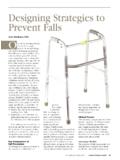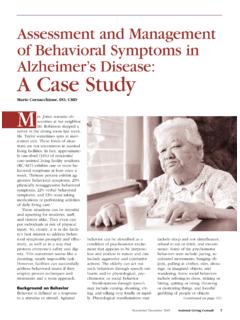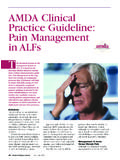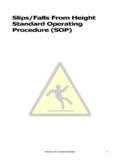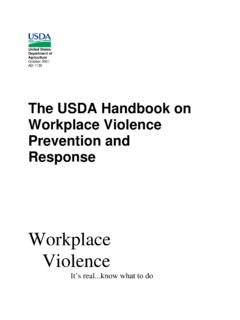Transcription of Falls and Fall Risk - Assisted Living Consult
1 Falls and fall Risk The American Medical Directors Association (AMDA) has utilized interdisciplinary expert panels to develop several clinical practice guidelines (CPGs) on key geriatric the organization's generosity, AMDA has made a summarized version of its CPGs available to allow our readers to begin thinking about the process needed to improve outcomes associated with these first CPG we will feature addresses a major problem for Assisted Living facilities Falls and fall risk. Falls are a main reason that residents leave ALFs and move to alternative , logic dictates that those ALFs that are able to reduce Falls will be able to retain residents longer and thus increase occupancy hope that facilities can use the information in this guideline to enhance Falls prevention efforts. Definition Falling is a problem characterized by the failure to maintain an appro- priate lying, sitting, or standing position, resulting in an individual's sudden, unintentional relocation either to the ground or into contact with another object below his or her starting point.
2 Introduction Falling is a significant cause of injury and death in older persons, especially the frail elderly. This is a major issue in Assisted Living facilities. Individuals in Assisted liv- ing facilities fall for a variety of reasons. Often, several factors (eg, age-related changes, acute or chronic conditions, medication effects, factors related to the resi- dent's environment or activities, inability or failure to follow safety measures, and/or physical weak- ness) are involved simultaneously. Among other things, decreased body mass and osteoporosis may ty, freedom, and quality of life. evidence of previous Falls . Ask the result in serious injuries as a con- These efforts will go a long way resident and the resident's caregiv- sequence of a fall . toward avoiding these preventable er or family if the individual has a Preventing Falls presents a signif- events and allowing Assisted Living history of falling. icant challenge in all settings, residents to age in place. including Assisted Living facilities, Step 2.
3 And requires a substantial interdisci- Step 1 Is the resident at risk of falling? plinary team effort. Such efforts Does the resident have a history Many risk factors are associated should focus on minimizing fall risk of Falls ? A history of Falls is a with Falls . Multiple factors often are and the risk of fall -related injuries strong predictor of future Falls . involved in a given individual. For while maximizing individual digni- Review the resident's record for (continued on page 28). 26 Assisted Living Consult January/February 2005. Falls and fall Risk such significant findings (so-called injury may sustain a more serious (continued from page 26) pertinent negatives ) to demon- injury in subsequent Falls . Those strate that the resident is being mon- with significant osteoporosis are example, a previous fall may gener- itored appropriately. more likely to sustain fractures of ate a fear of falling again, which the hip, wrist, and spine from Falls . results in reduced mobility and Step 4 Residents with reduced amounts of leads to deconditioning a loss of Define the nature, frequency, and muscle, fat, and subcutaneous tissue strength, balance, and agility that causes of a resident's Falls .
4 After an to absorb the impact of a fall also may rapidly follow a period of observed or probable fall or after a are more susceptible to fractures. immobilization. An acute illness fall risk has been identified, a more Current use of anticoagulants is a such as pneumonia may cause detailed analysis of the resident's risk factor for significant injury from lethargy, dizziness, or decondition- falling or fall risk should occur. Falls ; use of these medications may ing and thus lead to Falls . In addi- The nature of Falls or fall risk result in greater blood loss relative tion, the following comorbid condi- refers to their characteristics and to the degree of trauma. tions may be associated with Falls : related circumstances for example: Musculoskeletal problems that Buckling of the right knee or lean- Step 6. impair strength and biomechan- ing far to one side while trying to Develop a plan for managing Falls ics. Neurologic and cardiac ill- ambulate. A tendency to slide and fall risks .
5 Care goals related to nesses. from a chair while sitting. Falling falling are to try to prevent falling Orthostatic hypotension and med- after standing up or while trying and to prevent recurrent Falls in resi- ications that impair alertness and to get to the bathroom at night. dents who have fallen before. The balance or cause orthostatic management of Falls and fall risk hypotension. Frequency refers to the intervals may involve one or several meas- Urinary or fecal urgency that between Falls or between situations ures. Use a clear, consistent leads to frequent visits to the approach to select interventions to toilet. manage and prevent falling in indi- Visual impairments and peripher- vidual residents. Be aware that risk al neuropathies that impair posi- prediction is imprecise; some low- tion sense. risk individuals may fall , and some Provide staff with high-risk individuals may not. How- Document risk factors for falling ever, effective risk assessment should in the resident's record and discuss a clear, written enable facility staff to anticipate risks the resident's fall risk in care con- procedure that describes correctly more often than not.
6 Ferences. what to do when a It is appropriate to prioritize approaches to managing fall risk Step 3 resident Falls . and falling. That is, if a systematic Has the resident just fallen? Provide evaluation of a resident's fall risk staff with a clear, written procedure identifies several possible interven- that describes what to do when a tions, it is reasonable to choose one resident Falls . When a resident has of these interventions to try first. just fallen or is found on the floor that present a risk of falling. Was a If falling reoccurs despite the ini- without a witness to the fall , staff recent fall new or recurrent? Recur- tial intervention, additional or differ- should provide appropriate first aid. rent falling may require broader ent interventions may be needed. Notify the resident's attending attempts at cause identification than Adjust the resident's care plan as physician and family in an appro- isolated or occasional falling. necessary to reflect the implementa- priate time frame.
7 For Falls that do tion of new or modified interven- not result in significant injury or a Step 5 tions to try to minimize the risk of condition change, the practitioner Define the resident's actual and falling and fall -related injuries. Briefly may be notified routinely (eg, by potential complications of Falls . document the rationale for specific fax or by phone the next office Some Falls may result in significant interventions to show that causes of day) instead of immediately. complications. It is important to the problem are being sought. Document relevant post- fall clini- define complications of Falls and Although no specific efforts or cal findings such as vital signs, pain, significant potential complications combinations of interventions have swelling, bruising, and decreased of falling for each resident. been shown to prevent all Falls or mobility in the resident's record. It is For example, residents who have all injuries associated with falling, also desirable to note the absence of a history of Falls without significant it is often possible to reduce the 28 Assisted Living Consult January/February 2005.
8 Frequency of Falls and the severity mental factors that predispose resi- of injuries associated with falling. dents to falling also increase the risk Step 11. of serious consequences of these Conduct quality improvement Step 7 Falls . Many members of the interdis- activities related to Falls . Include Manage the causes of falling. Man- ciplinary care team, as well as staff analysis of Falls in the facility's qual- aging Falls can be complicated in support services such as house- ity improvement studies. Track acci- because many Falls do not result keeping and maintenance, can help dents and Falls by (at a minimum). from a single cause but rather from to address these risk factors. time, location, and identified cate- the interaction of several factors. gories of causes. The total number Successful fall management uses a Step 10 of Falls will fluctuate from month to systematic approach that may Monitor falling in individuals month. require repeated reassessment and with a fall risk or fall history.
9 As adjustment. previously noted, there are no Summary Cause-specific interventions are foolproof ways to prevent all Falls . Falling is a significant cause of injury only available and effective some- Further, it is often not possible to and death in older persons, espe- times. At other times, the best that predict with certainty whether a cially the frail elderly. Preventing can be done is to try various inter- particular intervention to manage Falls and minimizing fall -related ventions until Falls are reduced or falling or fall risk will be effective injuries constitutes a significant chal- stopped completely, or until an in a given resident. lenge for Assisted Living facilities and uncorrectable reason is identified Monitor and document the resi- requires a substantial interdiscipli- for continuation of the problem. dent's response to interventions nary team effort. Managing Falls Falls associated with medication requires recognizing that many Falls use. Evaluate the resident's drug do not result from a single cause but regimen carefully to identify med- rather from the interaction of numer- ications that may be precipitating ous intrinsic and extrinsic factors.
10 Falls . For example, many medica- Successful fall management uses a Preventing Falls and tions can cause dizziness or postur- systematic approach that may al hypotension, which can increase minimizing fall -related require repeated reassessment and fall risk. Falls that start after a injuries constitutes adjustment. Although no specific change in a resident's medications efforts or combinations of interven- a significant challenge should trigger a review of the resi- tions have been shown to prevent dent's entire medication regimen. for Assisted Living all Falls or injuries associated with Long-standing medications that may facilities and requires falling, it is often possible to reduce not have been problematic in the the frequency of Falls and the severi- a substantial past should be re-evaluated in con- ty of injuries associated with falling. junction with recent acute illnesses interdisciplinary The complete Falls and fall or general condition changes. team effort. Risk clinical practice guideline is available from AMDA at Step 8 ALC.
